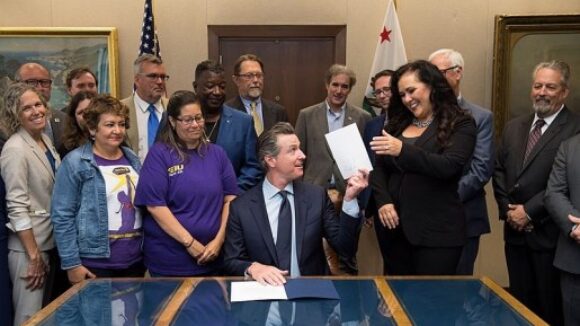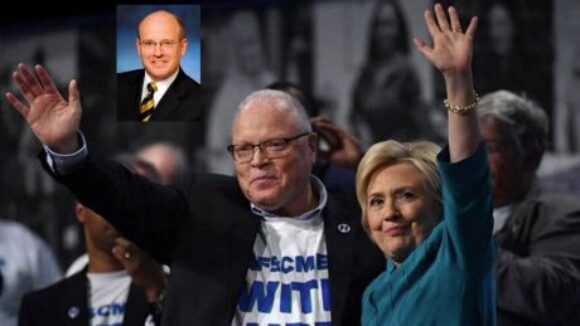‘People Have a Right to Make Their Own Choice’
Avelo employee Kim Howard believes all the firm’s flight attendants should get to vote on continued AFA rule. Credit: WTNH-TV (ABC,…

In recent years, beleaguered private-sector employees and employers and other taxpayers in forced-unionism Illinois have seen their tax burdens skyrocket, their public debt liability soar, and the quality of their K-12 schools and other vital public services deteriorate.
According to an analysis issued this April by the non-partisan, Washington, D.C.-based Tax Foundation, state-and-local tax collections will consume 12.9% of Illinois’s net output this year.
That means Illinoisans will be forking over a higher share of their earnings to state and local politicians than the residents of every other state in the Midwest, and higher than in 43 of the other 49 states nationwide.
The Prairie State’s property tax bills are particularly onerous.
According to Wirepoints, a Wilmette, Ill.-based nonprofit watchdog, when measured as a percentage of home values, Illinois property taxes are currently “the highest in the country.”
Moreover, as a share of combined household incomes, they’re up more than 60% since the beginning of the 1990s!
A vast and rapidly growing share of the property and other state-local taxes paid by Illinoisans goes into covering the cost of government pensions and retirement health benefits. Even so, state-and-local retirement fund shortfalls keep worsening.
Late last year, a Wirepoints analysis of Moody’s Investors Services debt estimates found that Illinois’s retirement debts increased by nearly $100 billion between 2019 and 2020 alone, to reach $530 billion.
That means “each Illinois household is now on the hook for, on average, $110,000 in government-worker retirement debts.”
National Right to Work Committee Vice President John Kalb commented:
“Even after years and years of sluggish growth stemming from its excessive taxes and regulations, Illinois retains important economic pluses. It is still home to vast numbers of talented and conscientious workers, and to 38 Fortune 500 companies.
“But as a consequence of misgovernance by Big Labor puppet politicians, Illinois is also a fiscal basket case.
“Fortunately, recent American history offers Illinoisans ample reason to hope that they can get their state’s Big Government abuses under control and reverse its decline.
“And history also shows that curtailing government union monopolists’ special privileges and abolishing all compulsory union dues and fees are keys to limiting the size of government.”
To illustrate the point, Mr. Kalb pointed to the experience of Illinois’s northern neighbor, Wisconsin.
In 2011, under then-Gov. Scott Walker (R), Wisconsin enacted the landmark budgetary reform known as Act 10. At the time, the National Right to Work Committee and its Wisconsin members helped mobilize support for this important reform.
Critical provisions in Act 10 established Right to Work protections for public servants and sharply narrowed the scope of government union officials’ monopoly power to bargain over how public servants are compensated and managed.
In 2010, the last year prior to Act 10’s enactment, Wisconsin’s overall state-local tax burden as a share of its net output was higher than those of all but four other states, and 7% higher than Illinois’s.
But this year, Wisconsin’s estimated average tax burden is lower than those of 18 other states, and 16% lower than Illinois’s.
Meanwhile, Act 10 has in multiple ways made it possible for local elected officials to allocate resources more wisely.
For example, it has empowered school districts to switch out of overpriced, but Big Labor-favored, health insurance plans without needing to get union bosses’ permission first.
Not surprisingly, Act 10’s implementation has been associated with rising student math proficiency statewide and within different types of school districts located across the state.
In 2015, Wisconsin elected officials built upon the Act 10 reform by adopting a state law extending Right to Work protections to private-sector employees throughout the state.
Once again, the National Right to Work Committee and its Badger State members helped mobilize grassroots activists to encourage their legislators to stand up to Big Labor pressure.
With Wisconsin and other Right to Work states now consistently beating forced-unionism Illinois in the competition for job-creating business investments and talented employees, it is getting harder and harder for the union-label politicians who control the state capital to justify the current regime.
“For the time being, state AFL-CIO President Tim Drea and his cohorts are still calling the shots in Springfield, but they are obviously getting more and more concerned about their future grip on power,” commented Mr. Kalb.
“That’s why Mr. Drea and Co. have decided to launch a preemptive strike against Right to Work in Illinois.”
“Last year,” Mr. Kalb continued, “Big Labor successfully prodded majorities in both chambers of the Illinois General Assembly to put on the November 2022 statewide ballot a power grab known as Amendment 1.
“If a current legal effort to take Amendment 1 off the ballot fails, and if voters approve it, this scheme will make it impossible for Illinois’s elected officials to adopt a Right to Work law or restrict substantially Big Labor’s monopoly privileges in any other way.
“Along with an array of other citizen groups, National Right to Work will be mobilizing opposition to Amendment 1 if it remains on the ballot. Passage of this cynical measure would be a disaster for Illinois and its workers and taxpayers.
“At the same time, there is a real possibility Amendment 1 will backfire on Illinois union bosses.”
The fact is, just 10 years ago, then-United Autoworkers union President Bob King and other union officials similarly tried to stave off Right to Work progress in Michigan by concocting a ballot initiative, very similar in substance to Amendment 1, known as Proposal 2.
Unfortunately for Mr. King and his cohorts, the people of Michigan refused to buy what they were selling. After an intense campaign, during which National Right to Work lent its support to the opposition, a whopping 57.4% of Michigan voters opposed Proposal 2.
“Proposal 2’s defeat by a surprisingly wide margin actually emboldened many Michigan elected officials who had been sitting on the fence to support Right to Work,” said Mr. Kalb.
“On December 11, 2012, in two separate votes, the Michigan state House approved private- and public-sector Right to Work measures that had been adopted a few days earlier by the Senate.
“Hours later, then-Gov. Rick Snyder signed both bills into law.
“As tight as Big Labor’s grip over Illinois seems to be, history shows that Tim Drea and his allied politicians are taking a real risk by trying to cram Amendment 1 down ordinary citizens’ throats.
“If they fail to pull off their power grab, prospects for Illinois becoming a Right to Work state will be much brighter than they were before they started.”
This article was originally published in our monthly newsletter. Go here to access previous newsletter posts.
To support our cause and help end forced unionism, go here to donate

Avelo employee Kim Howard believes all the firm’s flight attendants should get to vote on continued AFA rule. Credit: WTNH-TV (ABC,…

California’s Big Labor-concocted A.B.5, signed into law by Gov. Gavin Newsom in 2019, made it almost impossible for workers and firms to bounce back after 2020’s COVID-19 lockdowns. Now Biden bureaucrats want to federalize A.B.5!

Mr. Fain undoubtedly knows full well that there is a complete disconnect between the UAW hierarchy and the UAW rank-and-file on the Biden presidency and whether workers will benefit from its extension for another four years.